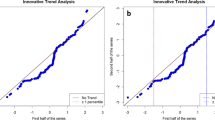Abstract
Design storms (DS) that are determined from intensity-duration-frequency (IDF) relationships are required in many water resources engineering applications. Short duration DS are of particular importance in municipal applications. In this paper, linear trends were estimated for different combinations of durations and frequencies (return periods) of annual short-duration extreme rainfall. Numerical analysis was performed for 15 meteorological stations from the province of Ontario, Canada. The estimated magnitude (rate mm/h) and direction of trend (increasing, decreasing, or no trend) were estimated and then used to quantify the effect of trend on the frequency of design storms. Significant trends were detected for all durations. It was determined that due to the existence of trends (which might be attributed to climate change), the design storms of a given duration might occur more frequently in the future by approximately as much as 36 years depending on the duration and return period.
Similar content being viewed by others
References
Adamowski K, Bougadis J (2003) Detection of trends in annual extreme rainfall. Hydrol Process 17:3547–3560
Adamowski K, Pilon P, Alila Y (1997) Regional short duration rainfall intensity-frequency formula for Canada. Paper presented at the international workshop on rainfall in urban areas, Pontresina, Switzerland, 4–7 December 1997
Bard E (2002) Climate shock: abrupt changes over millennial time scales. Phys Today 55:32–38
Bruce JP (1999) Disaster loss mitigation as an adaptation to climate variability and change. Mitig Adapt Strategies Glob Chang 4:295–306
Bruce JP, Burton I, Egener IDM, Theleb J (2002) Investigation of the potential municipal impacts and adaptation measures envisioned as a result of climate change. GCSI-Global Change Strategies International Inc
Cox D, Stuart A (1955) Some quick sign tests for trend in location and dispersion. Biometrika 42:80–95
Douville H, Chauvin F, Planton S, Royer J-F, Salas-Melia D, Tyteca S (2002) Sensitivity of the hydrological cycle to increasing amounts of greenhouse gases and aerosols. Clim Dyn 20:45–68
Gumbel EJ (1954) Statistics of extremes. Columbia University Press, New York
Guttman NB, Wallis JR, Hosking JRM (1992) Regional temporal trends of precipitation quantiles in the US. Research Report RC 18453 (80774). IBM Research Division, Yorktown Heights, NY
Hershfield DM (1961) Rainfall frequency atlas of the United States for durations from 30 minutes to 24 hours and return periods from 1 to 100 years. Technical Paper No. 40, U.S Weather Bureau, Washington, DC
Hogg WD, Carr DA (1985) Rainfall atlas for Canada. Atmospheric Environment Services, Environment Canada
IPCC (2007) Climate change 2007: The physical science basis contribution of working group I to the fourth assessment report of the intergovernmental panel on climate change. In: Solomon S, Qin D, Manning M, Chen Z, Marquis M, Averyt A, Tignor M, Miller HL (eds) Cambridge University Press, Cambridge, UK and New York, USA, p 996
International Research Institute for Climate Prediction (2002) Columbia University, annual report: 2002
Karl TR, Knight RW (1998) Secular trends of precipitation amount, frequency, and intensity in the United States. BAMS 79:231–241
Kendall MG (1962) Rank correlation methods. Hafner Publishing Company, New York
Maidment DR (1993) Handbook of applied hydrology. McGraw-Hill, NY
Mailhot A, Duchesne S, Caya D, Talbot G (2007) Assessment of future change in intensity-duration-frequency (IDF) curves for Southern Quebec using the Canadian Regional Climate Model (CRCM). J Hydrol 347:197–210
Mann HB (1945) Non-parametric tests against trend. Econometrica 13:245–259
Nicholls N (1995) Long-term climate monitoring and extreme events. Clim Change 31:231–245
Nicholls N, Gruza G, Jouzel J, Karl TR, Ogallo L, Parker D (1996) Observed climate variability and change. In: Houghton J, Meira Filho L (eds) The second IPCC scientific assessment of climate change. Cambridge University Press, Cambridge
Peterson T, Zhang X, Brunet-India M, Vazquez-Agguire J (2008) Changes in North American extremes derived from daily weather data. J Geophys Res D: Atmos 113:DO7113
Whang J, Zhang X (2008) Downscaling and projection of winter extreme daily precipitation over North America. Clim Change 21:923–937
World Meteorological Organization (1981) Selection of distribution types for extreme precipitation. Operational Hydrology Report No. 15, WMO-No 560, Geneva, Switzerland
Yagouti A, Boulet G, Vincent L, Vescovi L, Mekis E (2008) Observed changes in daily temperature and precipitation indices for southern Quebec, 1960–2005. Atmos-Ocean 46:243–256
Zhang X, Vincent L, Hogg WD, Niitsoo A (2000) Temperature and precipitation trends in Canada during the 20th century. Atmos.-Ocean 38:395–429
Zwiers FW, Kharin VV (1998) Change in the extremes of climate simulated by CCC GCM2 under CO2 Doubling. J Climate 11:2200–2222
Author information
Authors and Affiliations
Corresponding author
Rights and permissions
About this article
Cite this article
Adamowski, J., Adamowski, K. & Bougadis, J. Influence of Trend on Short Duration Design Storms. Water Resour Manage 24, 401–413 (2010). https://doi.org/10.1007/s11269-009-9452-z
Received:
Accepted:
Published:
Issue Date:
DOI: https://doi.org/10.1007/s11269-009-9452-z




